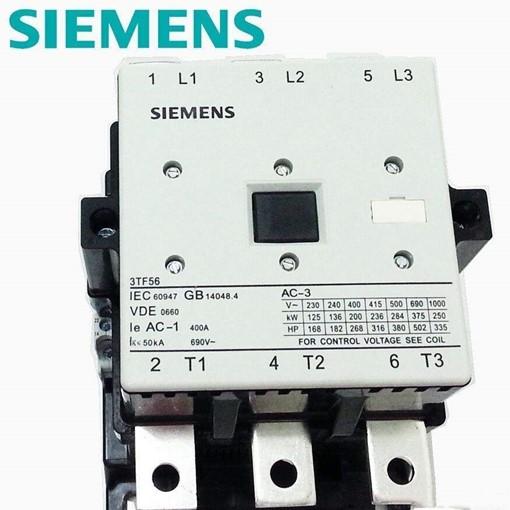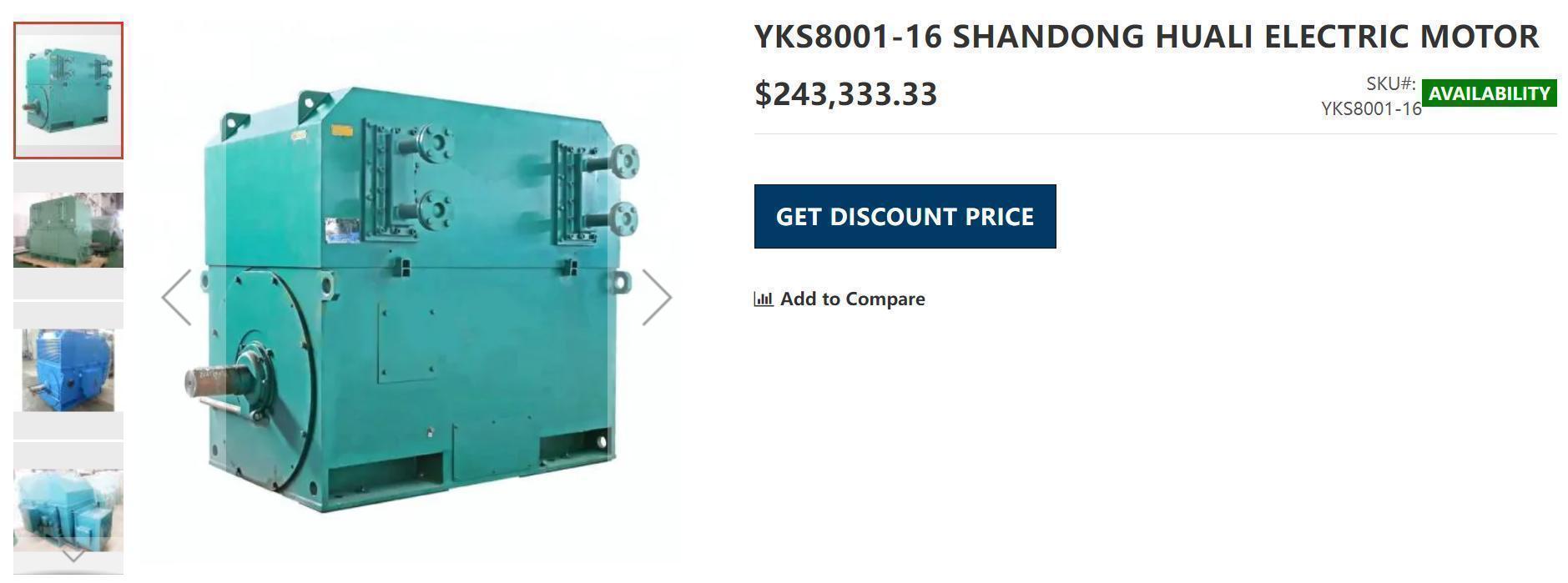Contactors are divided into alternating current contactors (voltage AC) and direct current contactors (voltage DC), which are used in power, power distribution and power consumption occasions. The contactor broadly refers to an electrical appliance that uses a current flowing through a coil to generate a magnetic field in industrial electricity to close the contacts to achieve load control.
The following is the product model and its introduction:
3RT2015-1BB41, 3TF5322-0XG0 205A AC36V, 3TF5244-0XM0 170A AC220V, 3TF5222-0XM0 170A AC220V, 3TF5144-0XM0 140A AC220V, 3TF5122-1XM4 140A DC220V, 3TF5044-0XQ0 110A AC380V, 3TF5044-0XB0 110A AC24V, 3TF5022-1XM4 110A DC220V, 3TF5022-0XQ0 110A AC380V, 3TF4844-0XM0 75A AC220V, 3RH1122-2KF40-0LA0, 3RT5044-1AN20, 3TB43 22-OX 36V, 3TB43 22-OX 110V, 3TB43 22-OX 220V, 3RT6026-1AQ00, 3RT6028-1AG20, 3TF5322-0XG0 205A AC36V, 3TF5322-0XF0 205A AC110V, 3TF5244-0XM0 170A AC220V, 3TF5222-0XQ0 170A AC380V, 3TF5222-0XM0 170A AC220V, 3TF5222-0XG0 170A AC36, 3TF5222-0XF0 170A AC110V, 3TF5222-0XB0 170A AC24V, 3TF5144-0XM0 140A AC220V, 3TF5144-0XF0 140A AC110V, 3TF5122-1XM4 140A DC220V
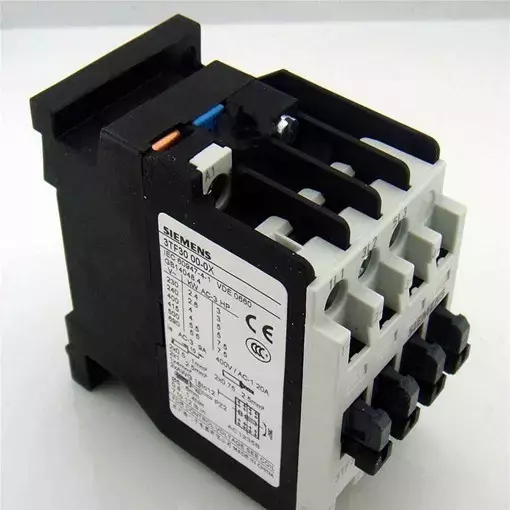
1. Siemens power contactor models for switching motors
1) Siemens contactor 3RT model, 3 poles, up to 250kW
Number of instantaneous NC contact: 0, 1, 2, 3, 4.
The number of NO contact instant contact: 1, 2, 3.
Working current is AC-3, voltage is 400V (unit A): 7, 9, 12, 16, 17, 25, 32, 38, 40, 51, 65, 80, 95, 110, 115, 150, 185, 225 , 265, 300, 400, 500.
Control version of the switch operating mechanism: fail-safe PLC input (F-PLC-IN), PLC-IN or standard A1-A2 (adjustable), standard A1-A2, standard A1-A2 can be selected through function modules, no operating mechanism .
Design of surge suppressor: use diode, with diode component, full wave rectification, and RC element, with suppression diode, with varistor.
Types of control power supply voltage: AC, AC / DC, DC.
Control the AC supply voltage at a frequency of 50Hz / 60Hz: 20V to 600V.
Control DC power supply voltage: 12V to 600V.
2) Siemens vacuum contactors 3RT12 and 3TF6 models
Number of NC contacts for auxiliary contact instantaneous contact: 2, 3, 4.
The working current is AC-3, the voltage is 400V (unit A): 225, 265, 300, 400, 500, 630, 820.
Control version of the switch operating mechanism: conventional, PLC-IN or standard A1-A2 (adjustable), standard A1-A2, no operating mechanism.
Design of surge suppressor: with varistor.
Types of control power supply voltage: AC, AC / DC, DC.
Control the AC supply voltage at a frequency of 50Hz / 60Hz: 21V to 600V.
Control DC power supply voltage: 21V to 600V.
The electrical connection type of the main current circuit of Siemens contactor: connection bar, screw terminal.
3) Siemens miniature contactor 3TF2 model, 3 poles
Connection type: flat connector 6.3x0.8mm, screw terminal, solder pin connection of printed circuit board.
Types of control power supply voltage: DC, 50Hz (60Hz) AC, 50 / 60Hz AC, 50 / 60Hz AC (USA + Canada).
Rated control power supply voltage:
12V DC;
24V AC / 50Hz and 29V / 60Hz;
24V AC / 50 or 60Hz;
24V DC;
42V AC / 50Hz and 50V / 60Hz;
48V AC / 50Hz and 58V / 60Hz;
48V DC;
52V DC / with varistor;
60V DC;
110V AC / 50 or 60Hz;
110V AC / 50Hz and 132V / 60Hz;
110V DC;
120V AC / 60Hz and 110V / 50Hz;
220V AC / 50 or 60Hz;
220V DC;
230V AC / 50 or 60Hz;
230V AC / 50Hz and 277V / 60Hz;
230V DC;
240V AC / 60Hz and 220V / 50Hz.
Siemens contactor auxiliary contacts: 1NC, 1NO, 1NO + 1NC, 2NO + 2NC.
4) Siemens power relay / mini contactor 3TG10 model
Connection: flat connector, screw terminal.
Rated control power supply voltage:
24V AC / 45 ... 450Hz;
24V DC;
110V AC / 45 ... 450Hz;
230V AC / 45 ... 450Hz.
Main contacts: 3NO + 1NC, 4NO.
All models of Siemens 3TG10 series are as follows:
3TG1001-0AC2; 3TG1001-0AG2; 3TG1001-0AL2; 3TG1001-0AL20-0AA0; 3TG1001-0BB4; 3TG1001-1AC2; 3TG1001-1AG2; 3TG1001-1AL2; 3TG1001-1BB4; 3TG1010-0AC2; 3TG1010-0AG2; 3TG1010-0AL2; 3TG1010-0AL20-0AA0; 3TG1010-1AC2; 3TG1010-1AG2; 3TG1010-1AL2; 3TG1010-1BB4.
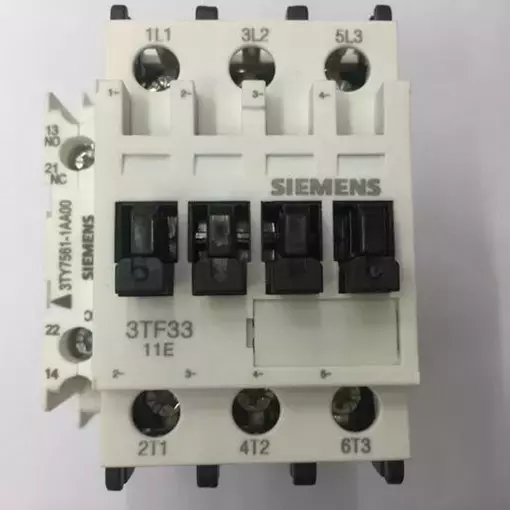
4) Siemens contactor 3RT1 model, 3 poles, up to 45kW
AC-3 working current is 400V rated value (unit A): 25, 32, 40, 50, 65, 80, 90.
The contactor controls the AC supply voltage at a rated value of 50 Hz: 24V to 500V.
The contactor controls the AC supply voltage at a rated value of 60 Hz: 24V to 600V.
Power supply voltage to control DC rating: 24V to 250V.
The number of NO contact instantaneous contact: 0, 1, 2.
Number of instantaneous NC contact: 0, 1, 2.
The size of Siemens contactor 3RT1 models are: S2, S3.
Types of electrical connections: spring terminals, screw terminals.
2. Siemens contactor models for special applications
1) Siemens contactor 3RT.4 type, used for resistive load (AC-1), 3 poles
Number of NC contacts for auxiliary contact instantaneous contact: 1, 2.
The working current is AC-1, the voltage is 400V (unit A): 130, 140, 250, 380, 450, 600, 650.
Control AC power supply voltage is 50Hz: 20V to 600V.
Control AC power supply voltage is 60Hz: 20V to 600V.
The contactor controls the DC power supply voltage: 20V to 600V.
Other Siemens contactor models are shown below
3RT.3 model, 4 poles, up to 525A;
3RT25 model, 4 poles, 2NO + 2NC;
3RT26 model is used for capacitive load (AC-6b), 3 poles;
3RT13 model, 4 poles, up to 140A;
Model 3TK1, for resistive load (AC-1), 4 poles;
Siemens miniature contactor 3TK20 type, used for resistive load (AC-1), 4 poles;
Siemens contactor 3RT14 type, 3-pole, maximum 140A for resistive load (AC-1);
3RT15 model, 4 poles, 2NO + 2NC;
3RT16 model is used for capacitive load (AC-6b), 3 poles;
3TC model, for switching DC voltage, 1 pole and 2 pole.
Device function:
In electrical engineering, because it can quickly cut off the main circuit of AC and DC and can frequently turn on and off the large current control (up to 800A) circuit, it is often used as a control object of electric motors, and can also be used to control factories For electrical loads such as equipment, electric heaters, working mother machines and various power units, the contactor can not only connect and cut off the circuit, but also have a low voltage release protection. The contactor has a large control capacity and is suitable for frequent operation and remote control. It is one of the important components in the automatic control system.
In industrial electrical, there are many types of contactors, and the working current ranges from 5A-1000A, and their uses are quite extensive.

Working principle:
The working principle of the contactor is: when the contactor coil is energized, the coil current will generate a magnetic field, and the generated magnetic field causes the static iron core to generate electromagnetic attraction to attract the moving iron core, and drive the AC contactor to act, the normally closed contact is opened, The normally open contact is closed and the two are linked. When the coil is de-energized, the electromagnetic suction force disappears, the armature is released under the action of the release spring, the contact is restored, the normally open contact is opened, and the normally closed contact is closed. The working principle of the DC contactor is similar to that of the temperature switch.
The main structure:
The AC contactor uses the main contact to control the circuit, and the auxiliary contact to turn on the control loop.
The main contact is usually a normally open contact, and the auxiliary contact often has two pairs of normally open and normally closed contacts. Small contactors are also often used as intermediate relays in conjunction with the main circuit.
The contacts of the AC contactor are made of silver-tungsten alloy, which has good conductivity and high temperature ablation resistance.
The power of the AC contactor is derived from the magnetic field generated by the AC through the coil with an iron core. The electromagnet core is composed of two "shan" shaped young silicon steel sheets, one of which has a fixed iron core and a coil. select. In order to stabilize the magnetic force, a short-circuit ring is added to the attraction surface of the iron core. After the AC contactor loses power, it relies on spring reset.
The other half is the movable iron core, which has the same structure as the fixed iron core, and is used to drive the closing and opening of the main and auxiliary contacts.
The contactor above 20A is equipped with an arc extinguishing cover, which uses the electromagnetic force generated when the circuit is disconnected to quickly pull off the arc and protect the contact.
The contactor can be operated at a high frequency. When the power is turned on and off, the maximum operating frequency can reach 1200 times per hour.
The service life of the contactor is very high. The mechanical service life is usually millions to 10 million times, and the electrical service life is usually hundreds of thousands to millions of times.
Technological development:
The AC contactor is made as a whole, and its shape and performance are constantly improving, but its function remains unchanged. Regardless of the degree of technological development, ordinary AC contactors still have their important position.
Air-type electromagnetic contactor (English: Magnetic Contactor): It is mainly composed of contact system, electromagnetic operating system, bracket, auxiliary contact and shell (or chassis).
Because the coil of the AC electromagnetic contactor is generally powered by an AC power supply, after the contactor is excited, there will usually be a high decibel noise, which is also the characteristic of the electromagnetic contactor.
Since the 1980s, countries have studied the silent and power saving of AC contactor electromagnets. One of the basic feasible schemes is to step down the AC power supply with a transformer and then convert it to DC power supply through an internal rectifier. However, this complex control method does not Rarely.
Vacuum contactor: The vacuum contactor is a contactor that uses a vacuum demagnetization chamber for the contact system.
Semiconductor contactor: A semiconductor contactor is a contactor that completes current operation by changing the on and off states of a circuit loop.
Permanent magnet contactor: The permanent magnet AC contactor is a micro power contactor formed by replacing the traditional electromagnet drive mechanism with a permanent magnet drive mechanism by using the principle of magnetic pole repulsion and opposite sex attraction.
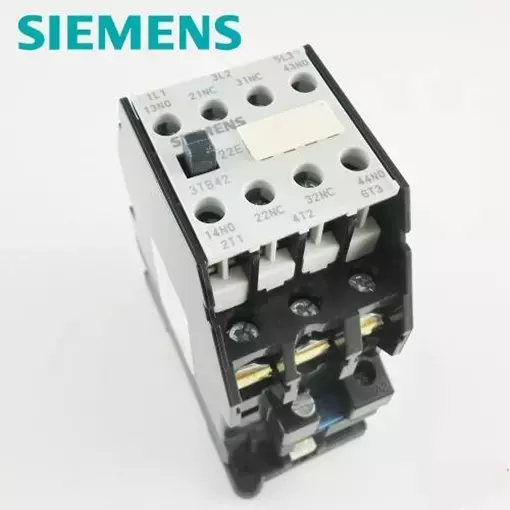
Main categories:
According to the form of the main contact connection circuit, it is divided into: DC contactor and AC contactor.
According to the operating mechanism, it is divided into: electromagnetic contactor and permanent magnet contactor.
Permanent magnet AC contactor is a kind of micro-power contactor which is formed by using the same pole of magnetic pole to repel and replace the traditional electromagnet drive mechanism with permanent magnet drive mechanism. Domestic mature product models: CJ20J, NSFC1, NSFC2, NSFC3, NSFC4 , NSFC5, NSFC12, NSFC19, CJ40J, NSFMR.
1) DC contactor
Development status of DC contactors at home and abroad
The overall development trend of the contactor will be toward the direction of long electrical life, high reliability, multi-function, environmental protection, multiple specifications, intelligence, and communication.
2) Hybrid DC contactor
Compared with AC current, there is no periodic current zero crossing point. Therefore, when the traditional contactor breaks the circuit, the arc generated between the contacts is strong, and the arcing time is relatively long, in order to fully release the circuit The remaining energy in the. The combustion of the arc generates high temperature and strong light, which has a serious ablative effect on the surface of the contact. The contact material is gradually lost after multiple interruptions. When the electrical wear of the contact is severe, the DC contactor is scrapped and the circuit cannot be broken. .
Power electronic technology has developed rapidly. People have applied power electronic components to DC contactors, and ingeniously created a hybrid DC contactor, making the DC contactor a new step toward intelligent and controllable. This hybrid contactor takes advantage of the small contact resistance and small conduction voltage drop of the traditional DC contactor in the closed conduction state, and connects the contactless switch composed of the anti-parallel thyristor and the control module unit in parallel to the traditional DC Contactor contacts. This non-contact power electronic switch does not generate an arc when breaking the circuit, which avoids the electrical wear of the arc on the contact material in the traditional contactor, and greatly increases the service life and reliability of the contact.
3) Permanent magnet mechanism of DC contactor
As one of the widely used electrical switches, the DC contactor has a huge production and demand. During normal use, the electromagnet coil is always energized to work, generating electromagnetic attraction, ensuring the iron core and armature are attracted, and driving dynamic and static contacts. Close and close the circuit. In the above process, there is resistance in the coil itself, which continuously consumes electrical energy. This is one of the main costs of using DC contactors and wastes a lot of energy and property. The key and difficult points of the device. The DC contactor permanent magnet operating mechanism is a hybrid operating mechanism developed on the basis of the traditional DC contactor electromagnetic operating mechanism, combining the electromagnetic operating mechanism and the permanent magnet, not only using the original electromagnetic The suction force and the spring reaction force are used as the power for the iron core to attract and separate, but the attraction of the permanent magnet to the iron core is added. The energy storage capacitor is used to charge and discharge to provide the closing and opening power. Magnetic retention, electronic control ". In the process of opening and closing, electromagnetic suction, permanent magnetic suction and spring force work together. During stable operation, permanent magnetic suction is used to replace the previous electromagnetic suction to maintain the state of the armature and core. For one thing, the permanent magnet operating mechanism greatly saves the power consumption of the holding coil, and is environmentally friendly and energy-saving. Secondly, compared with the electromagnetic attraction, the permanent magnet keeps attracting less noise and no pollution. Three, the permanent magnet operating mechanism eliminates a series of complicated and complicated lock protection devices in the electromagnetic mechanism, which greatly improves the working reliability of the contactor operating mechanism, reduces the production process and cost, and reduces the volume of the contactor.
According to the relevant standards in DIN EN 60947-4-1, the purpose and load characteristics of the contactor can be expressed by the characteristic value of the use category in combination with the rated working current value or the motor power and rated voltage. Generally speaking, a contactor can have several different use categories, but from an objective point of view, it mainly depends on the voltage, rated current and installation occasion of Siemens contactors. The specific use category selection principles are as follows.
1. Current type: AC, use category: AC-1, typical applications: non-inductive or low-inductive load such as resistance furnace.
2. Current type: AC, use category: AC-2, typical application place: start and break of winding motor.
3. Current type: AC, use category: AC-3, typical application place: three-phase asynchronous motor start and break during operation.
4. Current type: AC, use category: AC-4, typical applications: three-phase asynchronous motor starting, reverse connection braking or reverse operation, jog control.
5. Current type: AC, use category: AC-6b, typical application place: on-off of capacitor bank.
6. Current type: DC, use category: DC-1, typical applications: non-inductive or low-inductive load, such as resistance furnace.
7. Current type: DC, use category: DC-3, typical applications: start of parallel excitation motor, reverse connection braking or reverse operation, jog, resistance braking.
8. Current type: DC, use category: DC-5, typical applications: start of series-excited motor, reverse connection braking or reverse operation, jog, resistance braking.
Note: AC-3 allows the contactor to be used for occasional electric or reverse braking for a limited time, but the number of operations cannot exceed the range of 5 times per minute and 10 times per 10 minutes.

Principles of selection parameters of Siemens contactors:
Contactor type: The more commonly used main circuits are AC and DC, which play the role of controlling the motor and switching the resistive load.
Number of poles in main circuit: 3 poles and 4 poles are common in Siemens AC contactors, and 1 pole and 2 poles are common in Siemens DC contactors.
Main loop current: After determining the use category when selecting the device, the current of the contactor must be greater than the rated current of the motor, and the subsequent selection work should be performed according to the current parameters corresponding to the use category.
Main circuit voltage: This refers to the two-phase parameter of rated voltage and insulation voltage.
Control coil voltage and power consumption.
The number and capacity of auxiliary contacts.
Is the installation site a special application, such as a wide coil voltage used in railways?
Whether the altitude of the application place is reasonable, if it exceeds, it needs to consider the derating of the contactor.
Protective accessories can be appropriately configured during model selection to enhance safety and service life, such as surge suppressors, mechanical interlocks and other devices.
Finally, consider whether to choose domestic or imported Siemens contactors.
How to choose Siemens DC and AC contactors
First of all, the contactor is able to quickly turn on or off the AC and DC main circuits. Secondly, we need to consider which type of Siemens contactor to choose according to the type of the main circuit current. When switching AC is used, then the AC contactor can be used. Conversely, if switching DC is used, the DC contactor can be used.
Common rated voltage of Siemens contactors:
3TF model series: 3TF45 and below specifications equipment, rated voltage is 690V. The rated voltage of 3TF46 and above equipment is 1000V.
3RT model series: S00, S0, S2 contactors, rated voltage is 690V. For S3-S12 contactors, the rated voltage is 1000V.
